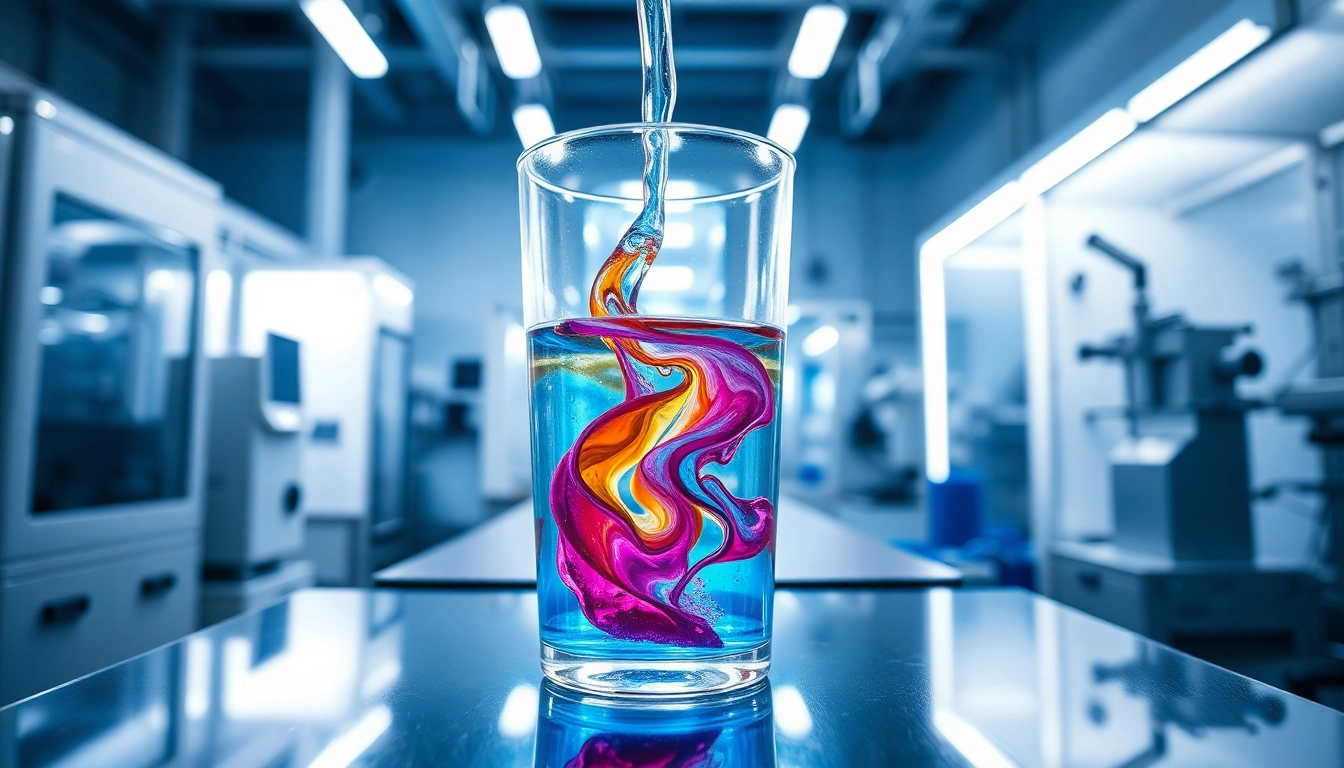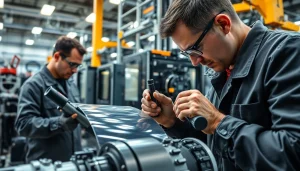Understanding Infusion Resins
What Are Infusion Resins?
Infusion resins are specialty resins used primarily in composite manufacturing, particularly in processes involving vacuum infusion techniques. These resins are characterized by their low viscosity, which enables them to flow easily into complex mold geometries, filling voids and ensuring a thorough saturation of reinforcing materials, such as fibers or mats. This ability to penetrate deeply is essential for achieving strong, lightweight composites that can perform under demanding conditions.
In the context of modern manufacturing, infusion resins serve a crucial role, enabling the creation of composite structures that are both robust and capable of maintaining clarity and structural integrity. As industries evolve, the need for innovative materials that can withstand various environmental factors and stresses has led to significant advancements in resin technology.
Properties and Benefits of Infusion Resins
Infusion resins offer a range of properties and benefits that make them suitable for a variety of applications:
- Low Viscosity: The low viscosity of these resins facilitates easy penetration into fiber mats and complex mold shapes, ensuring an even distribution and saturation of the fibers.
- Strength and Durability: Infusion resins, particularly epoxy-based formulations, provide superior mechanical properties. They can enhance the strength and stiffness of composite structures, making them suitable for aerospace, automotive, and marine applications.
- Low Shrinkage: These resins typically exhibit low shrinkage during curing, which is critical for maintaining dimensional stability and ensuring that components fit together properly without warping.
- Enhanced Clarity: Many infusion resins are formulated to offer high clarity and aesthetic appeal, making them ideal for applications where visual appearance is crucial, such as in architectural elements or consumer goods.
- Thermal and Chemical Resistance: Infusion resins often demonstrate excellent resistance to heat and chemicals, which is essential for components exposed to harsh environments.
Common Applications for Infusion Resins
Due to their unique properties, infusion resins find application in various sectors, including:
- Aerospace Industry: Lightweight yet strong components are critical in aerospace applications, where fuel efficiency and safety are paramount. Infusion resins are used to manufacture components such as wing structures, fuselage sections, and internal cabin fittings.
- Marine Applications: The boatbuilding industry utilizes infusion resins to create lightweight, durable hulls and decks that can withstand the harsh marine environment.
- Automotive Manufacturing: Infusion resins are employed in the production of body panels, structural components, and other elements where weight reduction and structural integrity are vital.
- Wind Energy: In the production of wind turbine blades, infusion resins help to create large components that require both stiffness and resistance to fatigue over time.
Types of Infusion Resins
Epoxy vs. Vinylester Infusion Resins
When it comes to infusion resins, two primary types dominate the market: epoxy and vinylester resins. Each type possesses distinct characteristics that make them preferable for different applications.
Epoxy Resins: These resins are known for their superior adhesive properties and mechanical strength. When cured, epoxy resins create a highly durable matrix that resists wear and degradation. This makes them ideal for high-performance applications, such as aerospace and automotive components. Furthermore, epoxy resins have excellent resistance to humidity and chemical exposure, which enhances their viability in harsh environments.
Vinylester Resins: Vinylester resins typically cure faster and are less expensive than epoxy alternatives. They combine the positive attributes of epoxies and polyesters, offering reduced shrinkage during curing and better corrosion resistance. As a result, vinylester resins are often used in marine and industrial applications, where exposure to chemicals and moisture is common. However, they may not provide the same level of mechanical performance seen in high-end epoxy systems.
Low Viscosity Infusion Resins
Low viscosity infusion resins are specifically formulated to offer optimal flow characteristics, allowing them to fill complex and intricate molds effectively. By reducing viscosity, these resins facilitate better wetting of fibers, ensuring consistent reinforcement of structural components. As manufacturers strive for efficiency and sustainability, low viscosity resins also help minimize waste during the infusion process, resulting in a more economical production cycle.
Bio-Based Infusion Resins
With growing environmental concerns, bio-based infusion resins have emerged as a sustainable alternative to traditional petroleum-derived resins. These formulations incorporate renewable materials, such as plant oils, into their composition while still maintaining desirable mechanical properties. The use of bio-based resins offers additional advantages, including reduced carbon footprint and potential regulatory benefits in certain markets focused on sustainability. As more industries adopt eco-friendly practices, bio-based infusion resins may become increasingly prominent in composite manufacturing.
Best Practices for Using Infusion Resins
Preparation Techniques for Optimal Results
Successful infusion resin applications depend heavily on meticulous preparation. Here are some best practices:
- Clean Mold Surfaces: Ensure all mold surfaces are free from contaminants such as grease, dust, or residues from previous casting. A clean mold enhances adhesion and reduces the likelihood of defects in the final product.
- Proper Venting: Incorporate adequate venting in your mold design. This allows air to escape efficiently as the resin is infused, preventing voids and ensuring uniform distribution throughout the fiber reinforcement.
- Accurate Resin Mixing: Follow manufacturer recommendations for mixing ratios and times. Improperly mixed resins can lead to incomplete curing or performance failures.
- Temperature Control: Monitor the temperature of both the resin and the environment during infusion. The temperature can significantly affect viscosity, curing speed, and final mechanical properties.
Handling and Safety Procedures for Infusion Resins
Working with infusion resins requires strict adherence to safety protocols:
- Personal Protective Equipment (PPE): Always wear appropriate PPE, including gloves, goggles, and respiratory protection when handling resins and hardeners.
- Work in Well-Ventilated Areas: Ensure your work area is well-ventilated to minimize inhalation of fumes and vapors.
- Store Resins Correctly: Follow manufacturer guidelines for resin storage, maintaining recommended temperatures and avoiding exposure to moisture or contaminants.
Common Mistakes to Avoid
Even seasoned professionals can encounter issues when using infusion resins. Here are common pitfalls and how to avoid them:
- Inconsistent Mixing: Always mix resins thoroughly to ensure consistent properties throughout the batch. Checking for incomplete mixing can prevent future issues during curing and final product performance.
- Over or Under Infusing: Pay close attention to flow rates and ensure that your resin supply matches the mold requirements. Under-infusion can lead to insufficient fiber saturation, while over-infusion can create excess resin weight.
- Ignoring Cure Times: Each resin formulation has specific curing times. Do not rush the process; allow adequate time for the resin to fully cure before demolding or subjecting it to stress.
Advanced Applications of Infusion Resins
Infusion Resins in Aerospace Manufacturing
The aerospace sector requires extremely high-performance materials that can withstand intense conditions without compromising safety. Infusion resins provide the necessary strength, weight reduction, and resilience to fulfill stringent aerospace standards. From constructing lighter fuselage components to fabricating wing structures, infusion resins enable the integration of complex geometries and minimize the overall weight, enhancing fuel efficiency.
Customizing Infusion Resins for Specific Needs
In the quest for optimized performance, customization of infusion resins is becoming more common. Manufacturers can tailor the properties of resins by varying the formulation’s components, such as fillers, catalysts, and additives. Custom infusion resins can enhance specific features like flame resistance, thermal stability, or impact resistance based on application requirements, offering manufacturers the flexibility to design precisely what their projects demand.
Future Trends in Infusion Resins Technology
The composite materials landscape is continuously evolving, and several trends indicate the future directions of infusion resins technology:
- Increased Sustainability: A significant emphasis is being placed on the development of sustainable resin systems. Innovations in bio-based resins and recycling technology for composites signal a commitment to responsible manufacturing practices.
- Rapid Curing Systems: Advances such as UV-curable resins or those that cure at room temperature will further streamline workflows in manufacturing environments.
- Smart Materials: Infusion resins integrated with sensing technology or shape memory capabilities are emerging, providing enhanced functionality and control over performance in real-time applications.
Performance Metrics and Evaluation
Testing the Strength of Infusion Resins
To evaluate the effectiveness of infusion resins, several performance testing methods are employed, including tension, compression, and shear strength testing. These tests are critical in determining whether the resin can withstand the desired loads in real-world applications.
Evaluating Clarity in Composite Products
In applications where aesthetics are essential, clarity becomes a key performance metric. Evaluating transparency can involve visual inspection techniques, as well as optical testing methods to quantify clarity and identify any optical defects resulting from the resin or fiber interactions.
Understanding Cost-Benefit Analysis of Infusion Resins
Assessing the cost-effectiveness of infusion resins requires a comprehensive analysis of material costs, processing expenses, and their potential to meet performance requirements over the product’s lifecycle. Decision-makers can enhance their production efficiency and sustainability by systematically evaluating the financial implications of selecting high-quality infusion resins.


